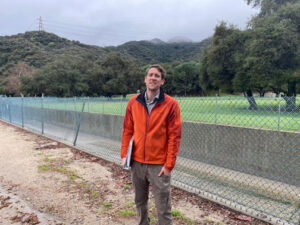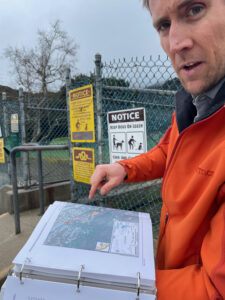
Photos by Mary O’KEEFE
With all of the recent rainfall, communities need to find ways to capture water to save it for non rainy days; however, that’s easier said than done.
By Mary O’KEEFE
Capturing rainwater has been a hot topic recently, now that California actually has measurable rainfall to capture, but for the Crescenta Valley Water District (CVWD) grabbing the rainwater before it goes out to sea has been something it has been planning for years.
This project was started by Dave Gould, former director of engineering and operations for CVWD. Regulatory and Public Affairs Manager Patrick Atwater has taken up that mantel.
The Crescenta Valley County Park Stormwater Recharge Facility Study Project was completed in 2017.
“The Crescenta Valley County Park Stormwater Recharge Facility Study (Project) is a grant-funded project to evaluate the feasibility of capturing stormwater and infiltrating it into the ground to augment local groundwater supplies. The Project is consistent with CVWD’s long-term goal of increasing the recharge of stormwater into the Verdugo Groundwater Basin (Basin), thereby increasing the amount of groundwater available to CVWD’s groundwater production wells and City of Glendale’s groundwater production wells in the Basin. Recharging more stormwater would give CVWD access to more lower-cost local groundwater and help reduce the amount of more expensive imported water that CVWD must purchase,” according to the study.
On a recent rainy day, Atwater walked with CVW along the Verdugo Wash near CV Park.
“We would put a pipe here [near the dog park] and another one down the wash,” Atwater said. “The water that would be captured would go into the groundwater.”

For many years the Crescenta Valley had a healthy supply of groundwater, which helped residents because CVWD had to purchase less water from Metropolitan Water, thereby keeping water charges low. The area used to be more water self-reliant but, as the drought continued, the groundwater supply was reduced.
As Atwater walked along the wash, water rushed past – a lot of water. It would seem natural, especially since earlier this month Gov. Gavin Newsom released the state’s updated Water Plan, to boost the ability to capture and store water for when dry times return. Since the state is flush [no pun intended] with rainwater this capture plan would be welcomed by all … except this is California where gold fever may have been historically dazzling; however, the real wealth is in water rights.
The water, Atwater explained, that flows down the Verdugo Wash through the La Crescenta and Glendale unincorporated areas of Los Angeles County belongs to Los Angeles.
“The [rainwater] goes down the wash to the LA River and then out to the ocean,” Atwater explained.
“We’ve all seen water flowing down the streets when it rains,” said CVWD Board President Sharon Raghavachary. “This project offers a common sense approach to recharge that water into the ground, saving both water for the future and also saving money for our community by avoiding expensive imported water.”
CVWD General Manager James Lee concurs.
“This project offers an incredible opportunity to provide a long-term, low-cost solution to the District. Regional imported water prices continue to go up at historic rates. It’s imperative that we don’t let arcane water rights dating back centuries stand in the way of doing what is right for La Crescenta and the broader region,” he said.
Capturing the water in the two areas along the wash would still allow rainwater to continue past those pipe points. There would still be water flowing into the LA River and to the sea; however, there would be some along the way diverted that would benefit the Crescenta Valley.
The City of Los Angeles Dept. of Water and Power is responsible for managing the City’s water rights under the Los Angeles City Charter.
Section 673(a) of the City Charter states, “The City shall not sell, lease or otherwise dispose of the City’s rights in the waters of the Los Angeles River, in whole or in part.” Sections 673(c) and 677(b), however, allow the City “[t]o enter into contracts with any public agency for the exchange of water as long as the water exchanged is replaced in full to the City within a reasonable period set by the board.”
“In other words, LADWP cannot allow Crescenta Valley Water District to use the City’s water rights, but can exchange water with Crescenta Valley,” according to an email response from LADWP to questions from CVW.
Although LADWP did state it was “always open” to discussing opportunities to collaborate and develop local water supplies, it was under the condition that they all comply with the City Charter water rights.
“I grew up in and love La Crescenta. This project is a no brainer for this community,” said Atwater. “With increased variability in imported water from the Colorado River and State Water Project, this stormwater project is exactly what Southern California needs. It’s time for us as a water community to work together collaboratively and do what’s right for the public we all serve.”
Next week CVW will look into the history of water in the local area and will, hopefully, have a response from Los Angeles Mayor Karen Bass, who has prioritized stormwater capture.
